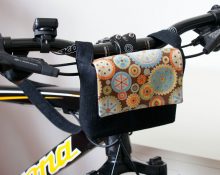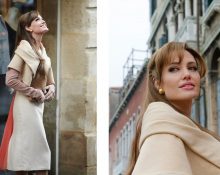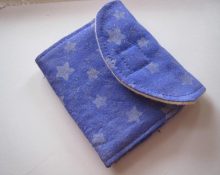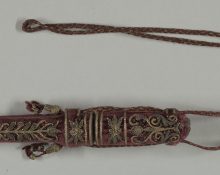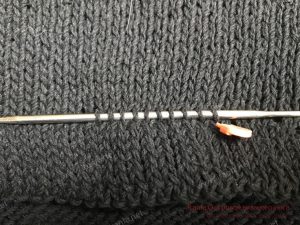
creativecommons.org
The drawstring is a rather convenient item of clothing that is often underestimated. Most often, drawstrings are sewn into sports-style products. Depending on the skill of the dressmaker, the drawstring can be used aesthetically and improve the appearance of the product. In this material we will tell you how novice dressmakers can knit a drawstring with knitting needles. At the end of the material you will find a step-by-step master class on knitting drawstrings, a diagram, a visual pattern, as well as successful examples of ready-made knitted items with drawstrings.
What is a drawstring and what types are they?
A drawstring is a piece of clothing that resembles a belt that can be attached to almost any item. Externally, the drawstring looks like a small strip of fabric sewn into the product. Sometimes the drawstring can look like a folded section of the product with a sewn-in tie. Most often, drawstrings are sewn in during the patterning of the product, but experienced craftswomen can add this detail to an old item by sewing it on later.Most often, a drawstring is used in sportswear to make the product fit better to the body and look better. Typically, drawstrings are sewn into the waist to highlight the silhouette, but recently drawstrings have become popular for hoods, sleeves or even collars. Today, drawstrings are increasingly used in products in a sporty style, called relaxed chic, as well as in dresses in the boho style. Drawstrings can be sewn into almost any product: into the waistband of a skirt or shorts, into a dress, into the hood of a sweatshirt, into trousers and even into a shirt. Recently, drawstrings have been sewn into straight-fit knitted dresses to achieve the popular hourglass silhouette. The drawstring has many forms: this part can be knitted, decorated in the form of ribbons or ribbons, and also made of fabric. There are also exotic options: drawstrings made of twine or scraps of leather. Moreover, sometimes drawstrings are used for interior decoration: this is how many housewives make drawstrings on curtains and curtains.
History of knitting
The first knitted item was found in the territory of modern Peru; archaeologists believe that it was made around the 3rd century. It's easy to guess that these were socks. However, most likely, people were familiar with the knitting technique much earlier. Archaeologist William Felkin, who observed Schliemann's excavations, suggested that the very principle of knitting was known to the Trojan inhabitants. This fan of Homer's work suggested that Penelope's famous fabric was not woven (this is the verb used in the vast majority of translations), but knitted. It is the knitting technique that would allow Odysseus’s faithful wife to create patterns on fabric during the day, and at night to unravel the product without damaging either the thread or the fabric itself.
The popularity of knitting was revived in the Middle Ages, approximately in the 13th century. Masters managed to knit bed linen even from silk threads. Much later, in the 16th century, the Spaniards began to knit stockings and gloves. At the same time, the first knitting machine was designed to simplify the knitting of such products. The masculine gender in the previous sentences is not indicated by chance; the fact is that until the 18th century, knitting was a male occupation. When women tried to join the guild, they met desperate resistance from the male sex. So much so that in 1612 the masters declared that they would not allow ladies into their ranks, even despite monetary sanctions. Knitting became an exclusively female activity only many years later. By the 19th century, knitting had transformed from a craft into a real art: lace making had reached the level of jewelry. Works made by Irish craftswomen, who in turn took expensive Brussels lace as a model, were especially valued.
Knitting is still popular not only among retired grandmothers, but also among young mothers and simply lovers of creativity. In general, researchers count about thirty methods of knitting, carried out using different tools: traditional knitting needles, a hook, a fork, a shuttle, bobbins, a lum and even a bone needle.
What you need to knit a drawstring
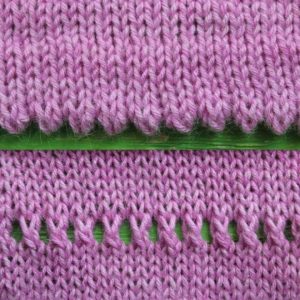
creativecommons.org
For beginners, it is best to start practicing on old things in order to gradually understand the details of the work process and not spoil the product. In any case, be prepared that the first time you are unlikely to get a store-bought product in a casual chic style.For such experiments it is worth setting aside a few hours of free time and not rushing. For knitting you will need standard knitting needles and a ball of yarn that matches the color and texture of your product.
Step-by-step master class with a drawstring knitting pattern
The drawstring must be knitted with the same pattern as the main fabric of the product. If there is a task to deliberately highlight the drawstring, then usually this element is knitted either with a 2x2 elastic band or with a standard stockinette stitch pattern.
The algorithm of actions is as follows:
- Determine the width of the drawstring On average, for a standard product, the width of the drawstring is fixed and is about four centimeters.
- Knit four centimeters with a standard pattern.
- Next, tie the same distance additionally; this indentation is needed for the hem.
- The next step is to fold the drawstring and secure the fold on the reverse side.
- Connect the drawstring to the main fabric with an additional seam.
- The threads can be tightened by fixing the desired width.


 0
0